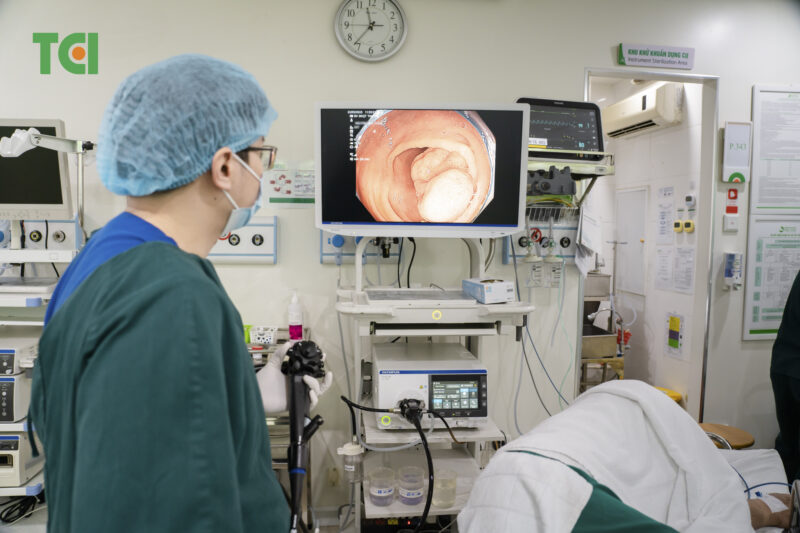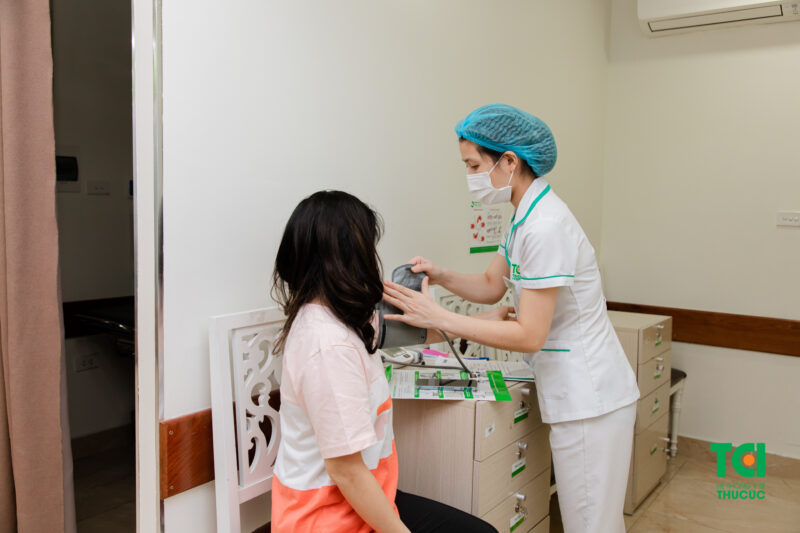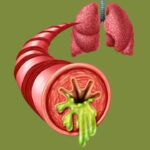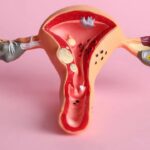Colon polyps are often benign, but there are cases where cells can turn malignant. Therefore, removing polyps is a crucial measure for preventing colorectal cancer. Among the available treatment methods, colonoscopic polypectomy offers numerous advantages and high effectiveness.
1. What Are Colon Polyps?
Colon polyps are abnormal protrusions in the colon’s mucosal layer, which can be either pedunculated (with a stalk) or sessile (without a stalk) with varying degrees of risk. A person may have one or multiple polyps in the colon simultaneously.
Colon polyps are a common gastrointestinal condition, with higher prevalence in middle-aged and elderly individuals (typically from age 45). Those with a family history of polyps are also at a higher risk.

The image shows a large polyp, nearly 3 cm in size, occupying almost the entire circumference of the colon lumen.
2. Why Should Colon Polyps Be Removed?
Most polyps are benign and asymptomatic, posing no immediate danger. However, some polyps can grow and transform into malignant cells, increasing the risk of cancer. It is estimated that up to 50% of colorectal cancer cases develop from polyps.
When polyps are detected during a colonoscopy, doctors will assess their shape, size, and characteristics to estimate the risk of malignancy. High-risk polyps are recommended for removal, often performed immediately during the colonoscopy. This guideline is supported by gastroenterological associations worldwide. Early removal of polyps can prevent gastrointestinal cancer by up to 80%.

Colonoscopic polypectomy is a method that helps prevent gastrointestinal cancer.
3. Steps for Colonoscopic Polypectomy
At TCI – Thu Cuc Healthcare System, colonoscopic polypectomy is performed following a standardized procedure:
– Clinical Examination: The patient undergoes a clinical examination with a specialist to identify symptoms and determine the appropriate endoscopic method.
– Pre-Procedure Tests: Blood pressure, weight, height, and necessary diagnostic tests are performed.
– Colon Cleansing: The colon must be cleansed before the procedure. This step can be skipped if the patient has already done it at home.
– Preparation: The patient is moved to the endoscopy area, given an anti-foam medication, and an intravenous line is set for anesthesia.
– Anesthesia: The patient is moved to the endoscopy room and sedated.
– Colonoscopy: The doctor begins the colonoscopy to locate polyps.
– Assessment: Upon detecting polyps, the doctor evaluates their condition to plan the removal.
– Removal: Specialized instruments are used to excise the polyps during the colonoscopy.
– Recovery: The patient is moved to a recovery area to rest and the intravenous line is removed.
– Post-Procedure Monitoring: The patient rests for at least 30 minutes and blood pressure is checked.
– Results and Follow-Up: The patient discusses the endoscopy results with the doctor and – receives further treatment instructions.
During the colonoscopy, tissue samples are taken for biopsy to check for cancer risk. Biopsy results are typically available within 3-5 days, with immediate results possible in a few hours if needed.
4. Advantages of Colonoscopic Polypectomy
4.1. Pain-Free Procedure
Colonoscopic polypectomy is performed under anesthesia, ensuring the patient is asleep and pain-free during the procedure. This method is minimally invasive, causing little to no discomfort. Most patients recover quickly and can resume normal activities shortly after waking up.

The patient is alert and healthy after undergoing a colonoscopic polypectomy.
4.2. Minimal Complications and Preservation of Colon Structure
The procedure is safe and rarely results in complications when performed by skilled doctors using modern equipment. Unlike open surgery, colonoscopic polypectomy only excises the affected mucosal tissue without the need to remove parts of the colon. Potential complications, such as bleeding or perforation, are rare and can be managed promptly to ensure a quick recovery. Symptoms like fever, chills, bloody stools, severe abdominal pain, vomiting, or irregular heartbeat after the procedure require immediate medical attention.
4.3. Quick Recovery Without Hospitalization
The procedure involves sedation, requiring a short rest period for the patient to regain alertness. Light meals and blood pressure monitoring are recommended post-procedure. If no abnormalities are detected, patients can go home the same day. Most cases do not require hospitalization, although patients with large polyps or those with higher risks might stay for 1-2 days for observation. Typically, recovery is swift, with complete healing within 1-2 weeks.
In recent years, the TCI – Thu Cuc Healthcare System has detected many polyp cases, including large precancerous or early cancerous polyps, during upper and lower gastrointestinal endoscopies. Early detection and colonoscopic polypectomy have significantly reduced the risk of colorectal cancer in patients.








